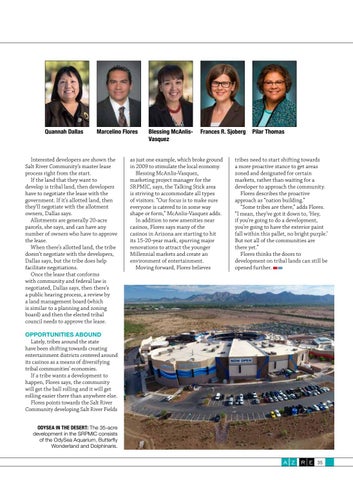Quannah Dallas
Marcelino Flores
Interested developers are shown the Salt River Community’s master lease process right from the start. If the land that they want to develop is tribal land, then developers have to negotiate the lease with the government. If it’s allotted land, then they’ll negotiate with the allotment owners, Dallas says. Allotments are generally 20-acre parcels, she says, and can have any number of owners who have to approve the lease. When there’s allotted land, the tribe doesn’t negotiate with the developers, Dallas says, but the tribe does help facilitate negotiations. Once the lease that conforms with community and federal law is negotiated, Dallas says, then there’s a public hearing process, a review by a land management board (which is similar to a planning and zoning board) and then the elected tribal council needs to approve the lease.
Blessing McAnlisVasquez
Frances R. Sjoberg
as just one example, which broke ground in 2009 to stimulate the local economy. Blessing McAnlis-Vasquez, marketing project manager for the SRPMIC, says, the Talking Stick area is striving to accommodate all types of visitors. “Our focus is to make sure everyone is catered to in some way shape or form,” McAnlis-Vasquez adds. In addition to new amenities near casinos, Flores says many of the casinos in Arizona are starting to hit its 15-20-year mark, spurring major renovations to attract the younger Millennial markets and create an environment of entertainment. Moving forward, Flores believes
Pilar Thomas
tribes need to start shifting towards a more proactive stance to get areas zoned and designated for certain markets, rather than waiting for a developer to approach the community. Flores describes the proactive approach as “nation building.” “Some tribes are there,” adds Flores. “I mean, they’ve got it down to, ‘Hey, if you’re going to do a development, you’re going to have the exterior paint fall within this pallet, no bright purple.’ But not all of the communities are there yet.” Flores thinks the doors to development on tribal lands can still be opened further.
OPPORTUNITIES ABOUND Lately, tribes around the state have been shifting towards creating entertainment districts centered around its casinos as a means of diversifying tribal communities’ economies. If a tribe wants a development to happen, Flores says, the community will get the ball rolling and it will get rolling easier there than anywhere else. Flores points towards the Salt River Community developing Salt River Fields ODYSEA IN THE DESERT: The 35-acre development in the SRPMIC consists of the OdySea Aquarium, Butterfly Wonderland and Dolphinaris. 35
